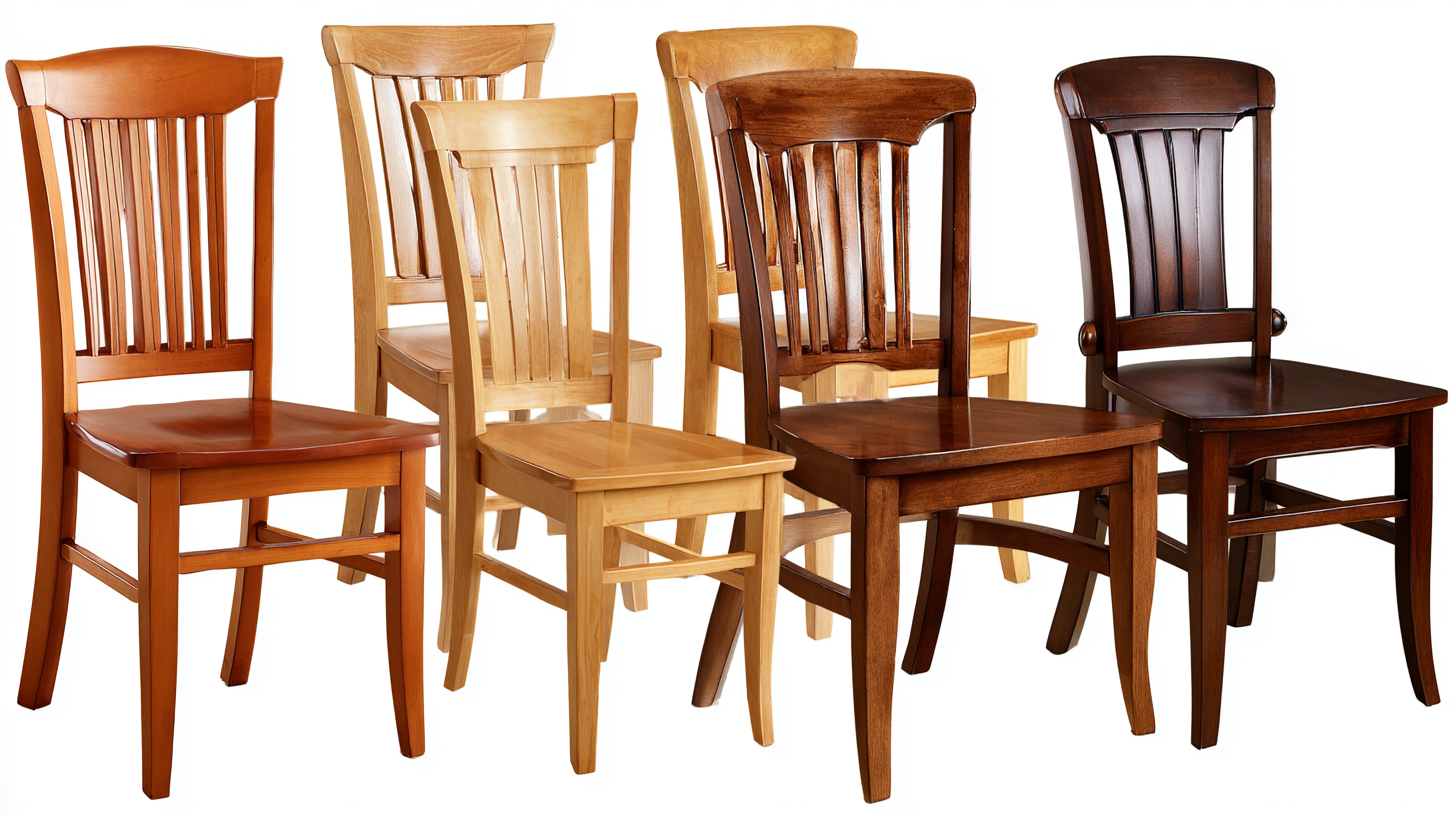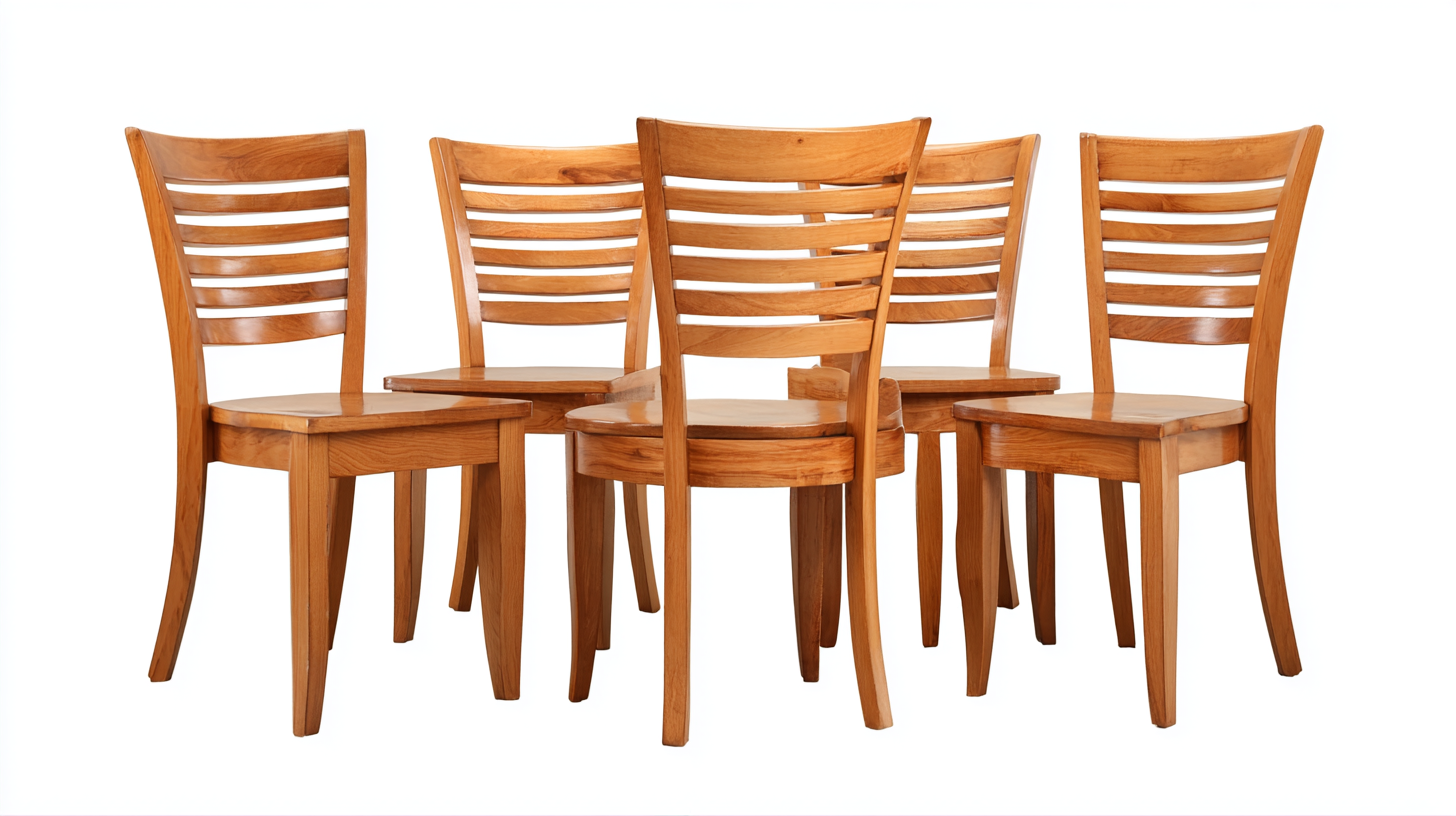
Common Issues with Choosing Best Wood Dining Room Chairs for Global Buyers
Choosing the right wood dining room chairs can significantly enhance the dining experience and elevate the aesthetics of any home. According to a recent industry report by Grand View Research, the global wooden furniture market is expected to reach a valuation of USD 600 billion by 2025, with dining room furniture representing a substantial segment of this growth. However, global buyers often face challenges such as material quality, design compatibility, and comfort levels when selecting the best wood dining room chairs that suit their unique preferences and needs.

To navigate these common issues, it is essential to understand the differences in wood types, construction techniques, and ergonomic features, empowering consumers to make informed decisions and invest in chairs that not only complement their dining spaces but also stand the test of time.
Identifying Quality Wood Materials: Key Attributes for Dining Room Chairs
When selecting wood dining room chairs, identifying quality wood materials is paramount for global buyers. A report by the American Home Furnishings Alliance indicates that nearly 44% of consumers consider durability the most important attribute when purchasing dining chairs. Thus, the type of wood used significantly influences not only durability but also the overall aesthetic appeal of the furniture. Hardwoods such as oak, maple, and walnut are highly favored for their robustness. Oak, for instance, is renowned for its resistance to wear and ability to withstand daily use, making it ideal for family homes.
Moreover, distinguishing key attributes of wood can be crucial. A study published in the International Journal of Furniture Research highlights that the grain structure, moisture content, and finish of the wood can impact its longevity and maintenance needs. Properly treated wood can enhance resistance to scratches and stains, a necessity for dining areas that frequently host gatherings. Additionally, buyers should be aware of certifications like the Forestry Stewardship Council (FSC), which ensures that the wood is sourced sustainably. This not only contributes to environmental preservation but also guarantees quality, providing peace of mind for consumers invested in long-lasting furniture solutions.
Common Issues with Choosing Best Wood Dining Room Chairs for Global Buyers
Evaluating Supplier Credentials: Essential Certifications and Industry Standards
When evaluating suppliers for wood dining room chairs, understanding their credentials is essential. Certifications and industry standards serve as indicators of a supplier's reliability and product quality. For instance, certifications like ISO 9001 can demonstrate a commitment to quality management systems, while environmental certifications validate sustainable practices in sourcing materials. This is increasingly important as consumers become more eco-conscious, and suppliers need to prove their adherence to sustainability standards.

Moreover, suppliers should undergo thorough vetting processes to ensure they meet specific industry requirements. This can include evaluating their financial health, experience in furniture manufacturing, and adherence to local and international regulations. In addition, understanding certification related to workplace safety and labor practices, such as those aligned with recognized labor standards, can provide insight into the ethical implications of sourcing from a particular supplier. Ultimately, conducting due diligence on these credentials can enhance buyer confidence and ensure a successful purchasing decision in the global market.
Understanding Global Trends: Popular Wood Types for Dining Room Chairs
When choosing the best wood dining room chairs, global buyers should consider current trends in popular wood types. In recent years, styles such as oak, walnut, and teak have surged in popularity, thanks to their durability and aesthetic appeal. Oak is favored for its strength and timeless look, while walnut’s rich color adds sophistication to contemporary settings. Teak, known for its resistance to moisture and pests, is an ideal choice for outdoor dining chairs, reflecting a growing interest in blending indoor and outdoor aesthetics.
**Tips**: When selecting wood dining chairs, prioritize the finish and type of wood. A clear finish can enhance the natural beauty of the wood grain, making a significant difference in aesthetics. Additionally, ensure the chairs have a comfortable seat height that pairs well with your dining table.
As the outdoor furniture market grows, with a projected size increase from $86.8 billion in 2025 to $137.1 billion by 2032, choosing robust and versatile wood types is increasingly important. Consider chairs that offer weather resistance if you plan to use them outside, as this will extend their lifespan and maintain their appearance.

Cost Considerations: Balancing Quality and Affordability in Supplier Selection
When selecting wood dining room chairs, global buyers often grapple with the challenge of balancing quality and affordability. According to a report from the International Wood Products Association, the global market for wooden furniture is expected to grow at a CAGR of 5.1% through 2026, underscoring the increasing demand for quality products. However, many suppliers often focus solely on cost, which can compromise craftsmanship and sustainability. This presents a dilemma for buyers looking for long-lasting and aesthetically pleasing dining chairs.
Cost considerations are paramount, yet spending less doesn’t necessarily equate to better value. A survey by Furniture Today found that nearly 30% of consumers reported dissatisfaction with the durability of low-cost furniture options. This dissatisfaction often leads to additional costs for replacements or repairs, negating the initial savings. Buyers should, therefore, seek suppliers who offer high-quality materials, such as hardwoods, alongside competitive pricing. By investing in well-built chairs, not only do consumers ensure longevity, but they also contribute to sustainable practices within the industry, as quality products often lead to less waste over time.
Common Issues with Choosing Best Wood Dining Room Chairs for Global Buyers - Cost Considerations: Balancing Quality and Affordability in Supplier Selection
| Dimension | Material Quality | Price Range ($) | Durability (Years) | Style Variety |
|---|---|---|---|---|
| Standard | High | 300 - 500 | 10 - 15 | Modern, Rustic |
| Compact | Medium | 150 - 300 | 5 - 10 | Contemporary, Minimalist |
| Extended | High | 500 - 800 | 15 - 20 | Traditional, Classic |
| Stackable | Medium | 100 - 250 | 3 - 7 | Functional, Versatile |
| Bar Height | High | 200 - 400 | 8 - 12 | Industrial, Chic |
Sustainability Matters: Choosing Environmentally Responsible Wood Suppliers
When selecting the best wooden dining room chairs, sustainability plays a vital role in the decision-making process for global buyers. The quest for environmentally responsible wood suppliers is increasingly important as consumers become more conscious of their ecological footprint. The shift towards sustainable wood sourcing not only helps ensure that forests remain vibrant and healthy but also supports local economies and communities that rely on these natural resources. Countries like Canada are leading the way with initiatives to promote responsible wood harvesting practices, emphasizing the importance of certified timber from well-managed forests.
Moreover, emerging alternatives such as bamboo are gaining traction in regions like Ethiopia, highlighting the potential for eco-friendly substitutes that reduce reliance on traditional wood and plastic materials. The exploration of sustainable building materials and the innovative technologies supporting them further underscore the need for responsible sourcing, shaping the future of the furniture industry. By prioritizing responsibly sourced wood, buyers not only contribute to environmental stewardship but also help maintain the balance of local ecosystems for generations to come.